In Deep: Peter David’s Aquaman (Part 1 of 5)
By Josh Dean
August 1, 2011 - 21:25
DC Comics
Writer(s): Peter David
Penciller(s): Martin Egeland, Esteban Maroto, Kirk Jarvinen
Inker(s): Brad Vancata
Colourist(s): Eric Kachelhofer, Tom McCraw
Letterer(s): Dan Nakrosis, Gaspar
Cover Artist(s): Various
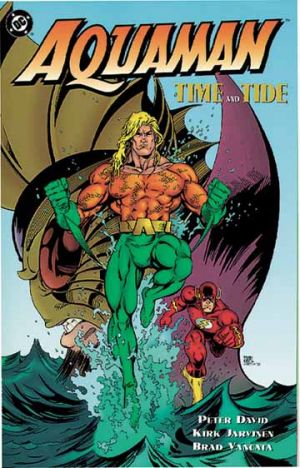 |
I say nearly because one writer managed to make it happen. Known mostly for his Marvel work on X-Factor and Hulk (or his Fallen Angel series), Peter David was able to craft a very engaging view of the Sea King that lasted 60 issues. I am going to break down this accomplishment into five parts of 12 issues each and look at what worked and what didn’t work for Aquaman as a lead character in his own book. Perhaps by looking at the past we can see what the future holds.
Part 1: The Atlantis Chronicles, Time & Tide, Aquaman #1
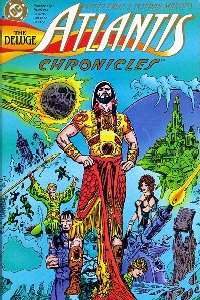 |
Over the course of seven issues, David and his artistic collaborator, Esteban Maroto, create a fantasy epic that spans generations and features not a single established character upon which to hang the series. Sure, it is all leading to the birth of Aquaman, but the series is set so far in the past that you can’t throw in a Batman cameo to boost sales. Rather, these annual-sized issues are stuffed to the gills with the history of Atlantis and that is about it.
The first five issues focus on the life story of King Orin and his belief in science as he clashes with his brother, Shalako, who still believes in the old gods of Atlantis. At the onset, Atlantis is a dry land community with a nice ocean view that is submerged when a meteor crashes to earth. Due to the building of a defensive (and airtight?) dome, the Atlanteans survive their kingdom’s journey to the bottom of the sea.
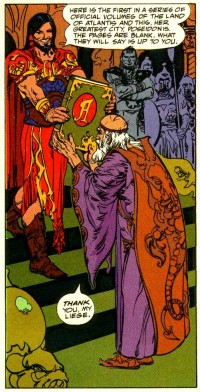 |
To recap the entire arc would take way more time and space than I have but, suffice it to say, you get a ton of needed info on Aquaman’s family tree. There are explanations for how Atlanteans breathe under water, why some are mermaids and mermen, and why blond hair is considered a bad sign. If you are foolish enough to try and read Peter David’s Aquaman run without reading this huge prologue, you are bound to feel like you are missing half the story.
The other big gamble with this is the super mature content. There is no warning label except that there is no “approved by the comic code” symbol on the front. I have been told that Maroto began as an erotic artist and his work here doesn’t give me any reason to doubt that. There is a lot of sex, some mild nudity, gory violence and even some family friendly rape in this story. I was honestly shocked by how much they got away with here. For a series that is fairly indispensable in regards to understanding later stories, this one is not really kid friendly.
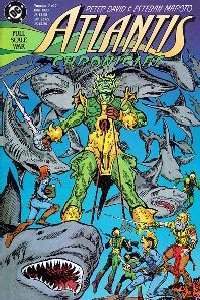 |
After setting up generations of in-fighting between brothers, science versus magic, Atlantis versus the rest of the world and other themes that would heavily resonate throughout David’s run; we are finally given the birth of Aquaman and his abandonment on mercy reef. Peter David then begins his next mini-series (Time and Tide) with the final words of The Atlantis Chronicles so that you pretty much have to assume this series follows directly.
Veering wildly away from the fantasy tone of Atlantis Chronicles, David sets out to immediately establish a few more key plot points in Aquaman’s past as well as integrate him into the super-hero milieu. This time, Kirk Jarvinen provides the very Art Adams style pencils of this four issue run. I clearly recall picking this up when I fell in love with the main Aquaman series hoping I would get some backstory only to realize I had missed something else even older (The Atlantis Chronicles). Not only does it read like the middle part of a story that is already in progress, there are some strange places where the events are rushed and crammed into the limited page count and read awkwardly.
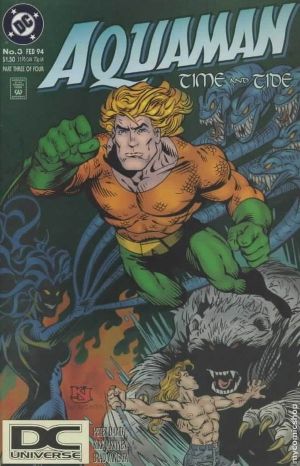 |
Now, if you read the Atlantis Chronicles, one of David’s cool tricks was that each issue was written by a different chronicler and their perceptions of the events influenced the narrative boxes. I can only assume Aquaman is kind of a crappy storyteller and that is why some of these issues read as rushed. There is even space in issue four devoted to explaining how Aquaman was able to switch to omniscient narrator in issue three for one scene.
Issue 2 explains why Aquaman loves dolphins and why a shark named Cron One-Eye is also Aquaman’s buddy. Issue three sets up an early run-in with the Ocean Master and gives the backstory of Aquaman’s illegitimate son (waaaay before Damien came back to bug Bats). There is also the introduction of the dark goddess of the sea in this issue, who becomes a major part of the ongoing series. Issue 4 deals with Ocean Master and the revelation that they are half-brothers both spawned by Atlan, a seemingly immortal prince of ancient Atlantis.
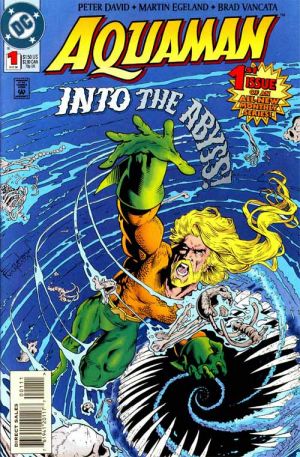 |
In part 2 we will look at the Zero issue that almost stubbornly sidesteps the entire Zero Hour nonsense, the coming of the famous hook hand, lots of DCU guest stars (Lobo and Superboy in the first year?), the basis for a Justice League cartoon episode, and the art of Martin Egeland.
Related Articles:
Aquaman - An Historiography
